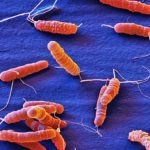Link to Pubmed [PMID] – 18682379
Mol. Cell Proteomics 2008 Dec;7(12):2429-41
In the human gastric bacterium Helicobacter pylori, two metalloenzymes, hydrogenase and urease, are essential for in vivo colonization, the latter being a major virulence factor. The UreA and UreB structural subunits of urease and UreG, one of the accessory proteins for Ni(2+) incorporation into apourease, were taken as baits for tandem affinity purification. The method allows the purification of protein complexes under native conditions and physiological expression levels of the bait protein. Furthermore the tandem affinity purification technology was combined with in vivo cross-link to capture transient interactions. The results revealed different populations of urease complexes: (i) urease captured during activation by Ni(2+) ions comprising all the accessory proteins and (ii) urease in association with metabolic proteins involved e.g. in ammonium incorporation and the cytoskeleton. Using UreG as a bait protein, we copurified HypB, the accessory protein for Ni(2+) incorporation into hydrogenase, that is reported to play a role in urease activation. The interactome of HypB partially overlapped with that of urease and revealed interactions with SlyD, which is known to be involved in hydrogenase maturation as well as with proteins implicated in the formation of [Fe-S] clusters present in the small subunit of hydrogenase. In conclusion, this study provides new insight into coupling of ammonium production and assimilation in the gastric pathogen and the intimate link between urease and hydrogenase maturation.


